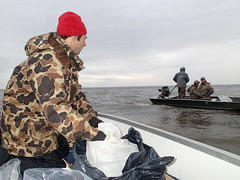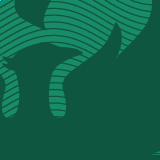Breaking the ice to spread the rice

Researchers from UW-Green Bay had to break skim ice on a cold morning in mid-November to do it, but they took another big step in a grant-funded pilot project to restore native wild rice, bulrush and wild celery stands to the lower bay.
Students, staff and faculty from UW-Green Bay’s Natural and Applied Sciences unit are behind the effort to seed areas near the mouth of Duck Creek as a first step in returning the desirable plants (for both birds and fish). UW-Green Bay received a $225,000 federal grant, in partnership with Ducks Unlimited, to pursue the habitat improvements in the lee of the new Cat Island Chain breakwater. The work will establish what size plantings are optimal, at what water depths, and the best means (seeding or plugs).
“This is an amazingly unique project on a global scale,” Prof. Matt Dornbush told Wisconsin Public Radio. “This type of stuff really hasn’t been done. So what we’re hoping to do is really try to develop restoration strategies. How do you actually restore these marsh communities to an area this big?” The project will encompass 1,400 acres (more than two square miles), and will take three years.
Top photo: right to left:
· Brianna Kupsky, current ES&P graduate student who is leading the “rice project.”
· Josh Martinez, former ES&P graduate student, now a wildlife biologist with the DNR.
· John Huff: Natural Resources Area Supervisor with the DNR.
Click to advance slideshow or view the album on Flickr.

– Photos by Reena Bowman, ES&P graduate student and Fish and Wildlife employee



